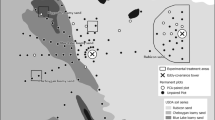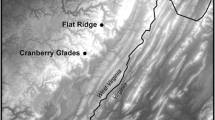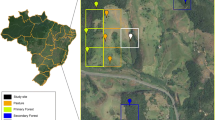Abstract
Forest disturbance and long-term succession towards old-growth are thought to increase nitrogen (N) availability and N loss, which should increase soil δ15N values. We examined soil and foliar patterns in N and δ15N, and soil N mineralization, across 800 years of forest succession in a topographically complex montane landscape influenced by human logging and wildfire. In contrast to expectations, we found that disturbance caused declines in surface mineral soil δ15N values, both in logged forests measured 40–50 years after disturbance, and in unlogged forests disturbed by severe wildfire within the last 200 years. Both symbiotic N fixation and N transfers from disturbed vegetation and detritus could lower soil δ15N values after disturbance. A more important role for symbiotic N fixation is suggested by lower soil δ15N values in slow-successional sites with slow canopy closure, which favors early-successional N fixers. Soil δ15N values increased only marginally throughout 800 years of succession, reflecting soil N uptake by vegetation and strong overall N retention. Although post-disturbance N inputs lowered surface soil δ15N values, steady-state mass balance calculations suggest that wildfire combustion of vegetation and detritus can dominate long-term N loss and increase whole-ecosystem δ15N. On steeper topography, declining soil δ15N values highlight erosion and accelerated soil turnover as an additional abiotic control on N balances. We conclude for N-limited montane forests that soil δ15N and N availability are less influenced by nitrate leaching and denitrification loss than by interactions between disturbance, N fixation, and erosion.





Similar content being viewed by others
References
Amundson R, Austin AT, Schuur EAG, Yoo K, Matzek V, Kendall C, Uebersax A, Brenner D, Baisden WT. 2003. Global patterns of the isotopic composition of soil and plant nitrogen. Glob Biogeochem Cycles 17:31-1–-10.
Aranibar JN, Macko SA, Anderson IC, Potgieter A, Sowry R, Shugart HH. 2003. Nutrient cycling responses to fire frequency in the Kruger National Park (South Africa) indicated by stable isotopes. Isot Environ Healt Stud 39:141–58.
Bai E, Houlton BZ, Wang YP. 2012. Global nitrogen hotspots across terrestrial ecosystems. Biogeosciences 9:3287–304.
Bai E, Boutton TW, Liu F, Wu XB, Archer SR. 2013. 15N isoscapes in a subtropical savanna parkland: spatial-temporal perspectives. Ecosphere 4:art4.
Barrett JE, Johnson DW, Burke IC. 2002. Abiotic nitrogen uptake in semiarid grassland soils of U.S. Great Plains. Soil Sci Soc Am J 66:979–87.
Bierlmaier FA, McKee A. 1989. Climatic summaries and documentation for the primary meteorological station. In: Andrews HJ, Ed. Experimental forest, 1972 to 1984. Portland: USDA Forest Service, GTR- PNW-242.
Billings S, Richter DD. 2006. Changes in stable isotopic signatures of nitrogen and carbon during 40 years of forest development. Oecologia 148:325–33.
Binkley D, Cromack K, Fredriksen RL. 1982. Nitrogen accretion and availability in some snowbrush ecosystems. For Sci 28:720–4.
Boeckx B, Paulino L, Oyarzun C, van Cleemput O, Godoy R. 2005. Soil δ15N patterns in old-growth forests of southern Chile as integrator for N-cycling. Isot Environ Health Stud 41:249–59.
Bormann BT, Homann PS, Darbyshire RL, Morrissette BA. 2008. Intense forest wildfire sharply reduces soil C and N: the first direct evidence. Can J For Res 38:2771–83.
Boutton TW, Liao JD. 2010. Changes in soil nitrogen storage and δ15N with woody plant encroachment in a subtropical savanna parkland landscape. J Geohys Res 115:G03019.
Bowman DM, Balch JK, Artaxo P, Bond WJ, Carlson JM, Cochrane MA, D’Antonio CM, Defries RS, Doyle JC, Harrison SP, Johnston FH, Keeley JE, Krawchuk MA, Kull CA, Marston JB, Moritz MA, Prentice IC, Roos CI, Scott AC, Swetnam TW, van der Werf GR, Pyne SJ. 2009. Fire in the Earth system. Science 5926:481–4.
Brenner DL, Amundson R, Baisden WT, Kendall C, Harden J. 2001. Soil N and 15N variation with time in a California annual grassland ecosystem. Geochem Cosmoch Acta 65:4171–86.
Brown MJ, Kertis J, Huff MH. 2013. Natural tree regeneration and coarse woody debris dynamics after a forest fire in the western Cascade Range. Portland: USDA Forest Service, PNW-RP-592.
Compton JE, Hooker TD, Perakis SS. 2007. Ecosystem N distribution and δ15N during a century of forest regrowth after agricultural abandonment. Ecosystems 10:1197–208.
Craine JM, Elmore AJ, Aidar MPM, Bustamante M, Dawson TE, Hobbie EA, Kahmen A, Mack MC, McLauchlan KK, Michelsen A, Nardoto GB, Pardo LH, Peñuelas J, Reich PB, Schuur EAG, Stock WD, Templer PH, Virginia RA, Welker JM, Wright IJ. 2009. Global patterns of foliar nitrogen isotopes and their relationships with climate, mycorrhizal fungi, foliar nutrient concentrations, and nitrogen availability. New Phytol 183:980–92.
Dunnette PV, Higuera PE, McLauchlan KK, Derr KM, Briles CE, Keefe MH. 2014. Biogeochemical impacts of wildfires over four millennia in a Rocky Mountain subalpine watershed. New Phytol 203:900–12.
Fry B. 2006. Stable isotope ecology. New York: Springer.
Galipaud M, Gillingham MAF, David M, Dechaume-Moncharmont F-X. 2014. Ecologists overestimate the importance of predictor variables in model averaging: a plea for cautious interpretations. Methods Ecol Evol 5:983–91.
Giesen TW, Perakis SS, Cromack K Jr. 2008. Four centuries of soil carbon and nitrogen change after stand-replacing fire in a forest landscape in the western Cascade Range of Oregon. Can J For Res 38:2455–64.
Giglia SK. 2004. Spatial and temporal patterns of “super-old” Douglas-fir trees of the central western Cascades, Oregon. MS Thesis, Oregon State University.
Griffiths RP, Homann PS, Riley R. 1998. Denitrification enzyme activity of Douglas-fir and red alder forest soils of the Pacific Northwest. Soil Biol Biochem 30:1147–57.
Griffiths RP, Madritch MD, Swanson AK. 2009. The effects of topography on forest soil characteristics in the Oregon Cascade Mountains. For Ecol Manag 257:1–7.
Grogan P, Bruns TD, Chapin FS. 2000. Fire effects on ecosystem nitrogen cycling in a Californian bishop pine forest. Oecologia 122:537–44.
Halpern CB, Lutz JA. 2013. Canopy closure exerts weak controls on understory dynamics: a 30-year study of overstory-understory interactions. Ecol Monogr 83:221–37.
Hart SC, Nason GE, Myrold DD, Perry DA. 1994. Dynamics of gross nitrogen transformations in an old growth forest: the carbon connection. Ecology 75:880–91.
Hilton R, Galy A, West AJ, Hovius N, Roberts GG. 2013. Geomorphic control on the δ15N of mountain forests. Biogeosciences 10:1693–705.
Hobbie EA, Macko SA, Shugart HH. 1998. Patterns in N dynamics and N isotopes during primary succession in Glacier Bay, Alaska. Chem. Geol. 152:3–11.
Högberg P. 1997. 15N natural abundance in soil-plant systems. New Phytol 137:179–203.
Homann P, Sollins P, Chappell H, Stangenberger A. 1995. Soil organic carbon in a mountainous, forested region: relation to site characteristics. Soil Sci Soc Am J 59:1468–75.
Houlton BZ, Bai E. 2009. Imprint of denitrifying bacteria on the global terrestrial biosphere. Proc Natl Acad Sci 106:21713–16.
Houlton BZ, Wang YP, Vitousek PM, Field CB. 2008. A unifying framework for dinitrogen fixation in the terrestrial biosphere. Nature 454:327–31.
Huber E, Bell T, Adams M. 2013. Combustion influences on natural abundance nitrogen isotope ratio in soil and plants following a wildfire in a sub-alpine ecosystem. Oecologia 173:1063–74.
Hyodo F, Kusaka S, Wardle DA, Nilsson MC. 2013. Changes in stable nitrogen and carbon isotope ratios of plants and soil across a boreal forest fire chronosequence. Plant Soil 364:315–23.
Johnson DW, Susfalk RB, Caldwell TG, Murphy JD, Miller WW, Walker RF. 2004. Fire effects on carbon and nitrogen budgets in forests. Water Air Soil Pollut Focus 4:263–75.
Karamanos RE, Rennie DA. 1980. Changes in natural 15N abundance associated with pedogenic processes in soil. II. Changes on different slope positions. Can J Soil Sci 60:365–72.
Klopsch MW. 1985. Structure of mature Douglas-fir stands in a western Oregon watershed and implications for interpretation of disturbance history and succession. MS Thesis, Oregon State University.
Kranabetter JM, Saunders S, MacKinnon JA, Klassen H, Spittlehouse DL. 2013. An assessment of contemporary and historic nitrogen availability in contrasting coastal Douglas-Fir forests through δ15N of tree rings. Ecosystems 16:111–22.
Martinelli LA, Piccolo MC, Townsend AR, Vitousek PM, Cuevas E, McDowell WH, Robertson GP, Santos OC, Treseder K. 1999. Nitrogen stable isotopic composition of leaves and soil: tropical versus temperate forests. Biogeochemistry 46:45–65.
McCune B. 2007. Improved estimates of incident radiation and heat load using non-parametric regression against topographic variables. J Veg Sci 18:751–4.
McLauchlan KK, Craine JM. 2012. Species-specific trajectories of nitrogen isotopes in Indiana hardwood forests, USA. Biogeosciences 9:867–74.
McLauchlan K, Higuera PE, Gavin DG, Perakis SS, Mack MC, Alexander H, Battles J, Biondi F, Buma B, Colombaroli D, Enders S, Engstrom DR, Hu FS, Marlon RR, Marshall J, McGlone M, Nave LE, Shuman BN, Smithwick E, Urrego D, Wardle DA, Williams CJ, Williams JJ. 2014. Reconstructing disturbances and their biogeochemical consequences over multiple timescales. Bioscience 64:105–16.
McNabb DH, Cromack K Jr. 1983. Dinitrogen fixation by a mature Ceanothus velutinus (Dougl.) stand in the western Oregon Cascades. Can J Microbiol 29:1014–21.
Menge DNL, DeNoyer JL, Lichstein JW. 2010. Phylogenetic constraints do not explain the rarity of nitrogen-fixing trees in late-successional temperate forests. PLoS ONE 5:e12056.
Menge DNL, Baisden WT, Richardson SJ, Peltzer DA, Barbour MM. 2011. Declining foliar and litter δ15N diverge from soil, epiphyte, and input δ15N along a 120,000 year temperate rainforest chronosequence. New Phytol 190:941–52.
Murtaugh PA. 2009. Performance of several variable-selection methods applied to real ecological data. Ecol Lett 12:1061–8.
Nesje AM. 1996. Spatial patterns of early forest succession following harvest in Lookout Creek Basin, OR. Master’s Thesis, Oregon State University, Corvallis, OR.
Pardo LH, Hemond HF, Montoya JP, Fahey TJ, Siccama TG. 2002. Response of natural abundance of 15N in forest soils to high nitrate loss following clear-cutting. Can J For Res 32:1126–36.
Perakis SS, Kellogg CH. 2007. Imprint of oaks on nitrogen availability and δ15N in California grassland-savanna: a case of enhanced N inputs? Plant Ecol 191:209–20.
Perakis SS, Sinkhorn ER. 2011. Biogeochemistry of a temperate forest nitrogen gradient. Ecology 92:1481–91.
Perakis SS, Sinkhorn ER, Compton JE. 2011. δ15N constraints on long-term nitrogen balances in temperate forests. Oecologia 167:793–807.
Perakis SS, Matkins JJ, Hibbs DE, Huso MM. 2012. N2-fixing red alder indirectly accelerates ecosystem nitrogen cycling. Ecosystems 15:1182–93.
Perakis SS, Sinkhorn ER, Catricala CE, Bullen TD, Fitzpatrick J, Hynicka JD, Cromack K Jr. 2013. Forest calcium depletion and biotic retention along a soil nitrogen gradient. Ecol Appl 23:1947–61.
Pérez CA, Thomas FM, Silva WA, Segura B, Gallardo B, Armesto JJ. 2014a. Patterns of biological nitrogen fixation during 60,000 years of forest development on volcanic soils from south-central Chile. N Z J Ecol 38:189–200.
Pérez CA, Aravena JC, Silva WA, Enríquez JM, Fariña JM, Armesto JJ. 2014b. Ecosystem development in short-term postglacial chronosequences: N and P limitation in glacier forelands from Santa Inés Island, Magellan Strait. Austral Ecol 39:288–303.
Peterson CE, Hazard JW. 1990. Regional variation in growth response of coastal Douglas-fir to nitrogen fertilizer in the Pacific Northwest. For Sci 36:625–40.
Poage NJ, Weisberg PJ, Impara PC, Tappeiner JC, Sensenig TS. 2009. Influences of climate, fire, and topography on contemporary age structure patterns of Douglas-fir at 205 old forest sites in western Oregon. Can J For Res 39:1518–30.
Rastetter EB, Vitousek PM, Field C, Shaver GR, Herbert D, Ågren GI. 2001. Resource optimization and symbiotic N fixation. Ecosystems 4:369–88.
Roering JJ, Kirchner JW, Dietrich WE. 1999. Evidence for nonlinear, diffusive sediment transport on hillslopes and implications for landscape morphology. Water Resour Res 35:853–70.
Sah SP, Rita H, Ilvesniemi H. 2006. 15N natural abundance of foliage and soil across boreal forests of Finland. Biogeochemistry 80:277–88.
Saito L, Miller WW, Johnson DW, Qualls RG, Provencher L, Carroll E, Szameitat P. 2007. Fire effects on stable isotopes in a Sierran forested watershed. J Environ Qual 36:91–100.
Schroeder TA, Cohen WB, Zhiqiang Y. 2007. Patterns of forest regrowth following clearcutting in Western Oregon as determined from Landsat time-series. For Ecol Manag 243:259–73.
Scott EE, Perakis SS, Hibbs DE. 2008. δ15N patterns of Douglas-fir and red alder riparian forests in the Oregon Coast Range. For Sci 54:140–7.
Shearer G, Kohl DH. 1989. Estimates of N2 fixation in ecosystems: the need for and basis of the 15N natural abundance method. In: Rundel PW et al., Eds. Stable isotopes in ecological research. Berlin: Springer. p 342–74.
Smithwick EAH, Turner MG, Mack MC, Chapin FS. 2005. Postfire soil N cycling in northern conifer forests affected by severe, stand-replacing wildfires. Ecosystems 8:163–81.
Sollins P, McCorison FM. 1981. Nitrogen and carbon solution chemistry of an old-growth coniferous forest watershed before and after cutting. Water Resour Res 17:1409–18.
Sollins P, Grier CC, McCorison FM, Cromack K Jr, Fogel R, Fredriksen RL. 1980. The internal element cycles of an old-growth Douglas-fir ecosystem in western Oregon. Ecol Monogr 50:261–85.
Spears JDH, Lajtha K, Caldwell BA, Pennington SB, Vanderbilt K. 2001. Species effects of Ceanothus velutinus versus Pseudotsuga menziesii, Douglas-fir, on soil phosphorus and nitrogen properties in the Oregon Cascades. For Ecol Manag 149:205–16.
Stephenson N. 1998. Actual evapotranspiration and deficit: biologically meaningful correlates of vegetation distribution across spatial scales. J Biogeogr 25:855–70.
Stock WD, Wienand KT, Baker AC. 1995. Impacts of invading N2-fixing Acacia species on patterns of nutrient cycling in two Cape ecosystems: evidence from soil incubation studies and 15N natural abundance values. Oecologia 101:375–82.
Sutherland RA, vanKessel C, Farrell RE, Pennock DJ. 1993. Landscape-scale variations in plant and soil nitrogen-15 natural abundance. Soil Sci Soc Am J 57:169–78.
Tepley AJ, Swanson FJ, Spies TA. 2013. Fire-mediated pathways of stand development in Douglas-Fir/Western Hemlock forests of the Pacific Northwest, USA. Ecology 94:1729–43.
Tepley AJ, Swanson FJ, Spies TA. 2014. Post-fire tree establishment and early cohort development in conifer forests of the western Cascades of Oregon, USA. Ecosphere 5:80.
Turekian VC, Macko S, Ballentine D, Swap R, Garstang M. 1998. Causes of bulk carbon and nitrogen isotopic fractionations in the products of vegetation burn. Chem Geol 152:181–92.
Vanderbilt KL, Lajtha K, Swanson F. 2003. Biogeochemistry of unpolluted forested watersheds in the Oregon Cascades: temporal patterns of precipitation and stream nitrogen fluxes. Biogeochemistry 62:87–117.
Vermes J-F, Myrold DD. 1992. Denitrification in forest soils of Oregon. Can J Forest Res 22:504–12.
Vitousek PM. 2004. Nutrient cycling and limitation: Hawai’i as a model system. Princeton: Princeton University Press.
Vitousek PM, Reiners WA. 1975. Ecosystem succession and nutrient retention: a hypothesis. Bioscience 25:376–81.
Vitousek PM, Mooney HA, Lubchenco J, Melillo JM. 1997. Human domination of Earth’s ecosystems. Science 277:494–9.
Wang LP, Shaner JL, Macko S. 2007. Foliar δ15N patterns along successional gradients at plant community and species levels. Geophys Res Lett 34:L16403.
Wang T, Hamann A, Spittlehouse DL, Murdock TQ. 2012. ClimateWNA—high-resolution spatial climate data for western North America. J Appl Meteorol Clim 51:16–29.
Weisberg PJ, Swanson FJ. 2003. Regional synchroneity in fire regimes of western Oregon and Washington, USA. For Ecol Manag 172:17–28.
Whitlock C. 1992. Vegetational and climatic history of the Pacific Northwest during the last 20,000 years. Northwest Environ J 8:5–28.
Yelenik SG, Perakis SS, Hibbs DE. 2013. Regional constraints to biological nitrogen fixation in post-fire forest communities. Ecology 94:739–50.
Zavitovski J, Newton M. 1968. Ecological importance of snowbrush Ceanothus velutinus in the Oregon Cascades. Ecology 49:1113–45.
Acknowledgments
We thank Mark Harmon, Kari O’Connell, Tom Giesen, Mark Schulze, and Patti Haggerty for site information, Chris Catricala, Morgan Luce, Bill Rugh, and Aaron Thiel for field and laboratory assistance, and Helga Van Miegroet and two anonymous reviewers for comments on the manuscript. Any use of trade names is for descriptive purposes only and does not imply endorsement by the US Government. This research was funded by National Science Foundation grant DEB 021-8088 to the Long-Term Ecological Research Program at the HJ Andrews Experimental Forest.
Author information
Authors and Affiliations
Corresponding author
Additional information
Author contributions
SSP and JEC conceived the study and performed research. SSP and AJT analyzed data. SSP wrote the paper with input from JEC and AJT.
Electronic supplementary material
Below is the link to the electronic supplementary material.
Rights and permissions
About this article
Cite this article
Perakis, S.S., Tepley, A.J. & Compton, J.E. Disturbance and Topography Shape Nitrogen Availability and δ15N over Long-Term Forest Succession. Ecosystems 18, 573–588 (2015). https://doi.org/10.1007/s10021-015-9847-z
Received:
Accepted:
Published:
Issue Date:
DOI: https://doi.org/10.1007/s10021-015-9847-z




